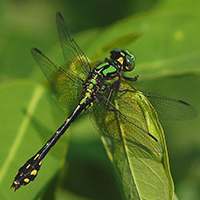Pygmy Snaketail
Scientific name: Ophiogomphus howei

Photo credit: Denis Doucet
Status
Endangered
“Endangered” means the species lives in the wild in Ontario but is facing imminent extinction or extirpation.
Date added to the Species at Risk in Ontario List
January 13, 2012
Read the most recent assessment report (PDF).
What it looks like
The Pygmy Snaketail is a small (31 to 37 millimetres long) dragonfly. It is dark brown and black, with vivid yellow markings on the abdomen and bright green ones on the thorax. Its wings have a large, transparent yellow-orange patch.
Pygmy Snaketails are believed to spend at least two years as larvae, and about six to eight weeks as flying adults.
Where it lives
Pygmy Snaketail larvae are found in large, fast flowing rivers having substrates of sand and gravel.
However, searches for larval skins at many apparently suitable waters have been unsuccessful, suggesting that the habitat may be more narrowly defined.
Adult Pygmy Snaketails live in the forest canopy adjacent to the river where they lived as larvae.
Where it’s been found in Ontario
There is just one record of a Pygmy Snaketail from Ontario, based on a larval skin collected in northwestern Ontario (Namakan River) in 2007.
Despite ongoing searches, no additional Ontario specimens have been found.
The species occurs in two separate regions – one in Wisconsin, Minnesota, and northwestern Ontario, and a more extensive eastern population ranging along the Appalachian Mountains from Tennessee to New Brunswick.
What threatens it
Larvae require clear, rapid, and unpolluted large rivers with fine sand or pea gravel bottoms.
Dam construction is a potential threat, along with water pollution resulting from excessive nutrient input from sewage, or sedimentation due to agricultural or forestry run-off. Pesticides and herbicides are also a potential threat.
Action we are taking
This species and its habitat are protected under Ontario’s Endangered Species Act, 2007 (ESA).
The ESA also requires us to prepare recovery guidance for endangered species such as Pygmy Snaketail to guide recovery efforts for the species in Ontario.
All species listed on the Species at Risk in Ontario List may be eligible for consideration for government funding through the Species at Risk Stewardship Program.
Recovery strategy
A recovery strategy advises the ministry on ways to ensure healthy numbers of the species return to Ontario.
Read the executive summary (January 11, 2013)
Read the recovery strategy (January 11, 2013)
Government response statement
A government response statement outlines the actions the government intends to take or support to help recover the species.
Read the government response statement (October 11, 2013)
Five-year review of progress
A five-year review of progress made toward protecting and recovering a species is required no later than five years after the government response statement for that species is published.
Read the report on progress towards the protection and recovery of 17 species at risk, including the Pygmy Snaketail (2018).
Habitat protection
General Habitat Protection - January 13, 2012
What you can do
Report a sighting
Submit your observations of species at risk to the Natural Heritage Information Centre (NHIC), which is Ontario’s conservation data centre. Join the Centre’s “Rare Species of Ontario” project in iNaturalist, an online plant and animal identification app, to make submitting your observations quick and easy.
Volunteer
Volunteer with your local nature club or provincial park to participate in surveys or stewardship work focused on species at risk.
Be a good steward
Private land owners have a very important role to play in species recovery. If you find Pygmy Snaketail on your land, you may be eligible for stewardship programs that support the protection and recovery of species at risk and their habitats, such as the Species at Risk Stewardship Program.
Report illegal activity
Report any illegal activity related to plants and wildlife to
Quick facts
- Adult Pygmy Snaketails are rarely seen because they spend much of their time in the forest canopy.
- The Pygmy Snaketail is the smallest of the snaketails and one of the smaller dragonflies in North America.
- The female Pygmy Snaketail dips the end of her abdomen into the water to release her eggs, which are carried by the current and eventually sink to the bottom of the river.
- During the day, Pygmy Snaketail larvae burrow up to 20 centimetres into the soil; at night, they come to the surface and drift with the current.